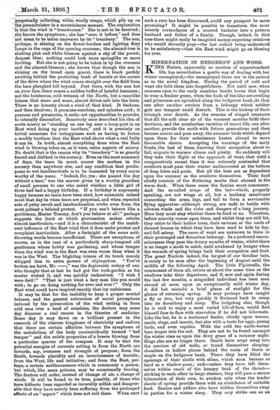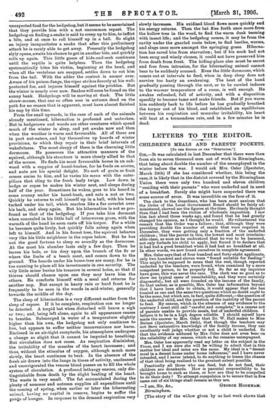HIBERNATION IN HEDGEROW AND WOOD.
R- IND Nature, apparently so careless of superabundant life, has nevertheless a gentle way of dealing with her winter unemployed,—for unemployed there are in the animal as in the social kingdom. During the period of cold and want ehe lulls them into forgetfulness. Not until now, when crocuses open to the early sunshine beside lawns that begin to wear a fresher green, when the buds of the lilac are swelling and primroses are sprinkled along the hedgerow bank, do they one after another awaken from a lethargy which neither gale nor tempest could disturb. This is the history of their triumph over dearth. As the swarms of winged creatures that fill the soft clear air of the warmest months fulfil their destinies, and the numberless varieties of insect life, one after another, provide the earth with future generations and then become scarce and pass away, the summer birds which depend upon them for their subsistence hasten abroad to more favourable shores. Accepting the warnings of the early frosts, the last of them, knowing their occupation about to fail, migrate to warmer climes and plenty. So suddenly will they take their flight at the approach of want, that until a comparatively recent time it was solemnly contended that swallows must pass their winter undiscovered at the bottom of deep lakes and pools. But all the bats are as dependent upon the Bummer as the swallows themselves. Their food chiefly consists of the fluttering moths that abound in the warm dusk. When these cease the famine must commence. And the so-called wings of the bat—which, properly speaking, are not wings at all, but a leathery membrane connecting the arms, legs, and tail to form a serviceable flying apparatus—although strong, are unfit to battle with adverse winds and the risks and dangers of a long journey. Here they must stay whether there be food or no. Therefore, before scarcity comes upon them, and whilst they are still fat, they retire to their hollow trees, their caverns, or the roofs of disused houses in which they have been used to hide by day, and fall asleep. The cares of want are unknown to them in their prolonged and dreamless lethargy. In a profound uncon- sciousness they pass the dreary months of winter, whilst there is no longer a moth to catch, until awakened by hunger when the warmth of spring brings back their occupation and food. The great Noctule indeed, the largest of our familiar bats, is rarely to be seen after the beginning of August until the middle of the following April. The little Pipistrelle, the commonest of them all, retires at about the same time as the swallows take their departure; and if, now and again during the last few months, a misguided individual has been seen abroad at noon upon an exceptionally mild winter day, it did but mistake a brief gleam of sunlight for the glance of returning spring. It may perhaps have caught a fly or two, but very quickly it fluttered back to creep into its dormitory and sleep. The hedgehog also, though he is said to enjoy a most varied bill-of-fare, would find himself face to face with starvation if he did not hibernate. Like the bat, he is a nocturnal feeder, chiefly upon worms, snails, slugs, and insects, but also with a taste for eggs, young birds, and even reptiles. With the cold the earth-worms bore deeper into the soil. They are not to be found amongst the winter rime as upon the dewy grass of a. summer night. Slugs also are no longer there. Snails have crept away into the crevices of old walls, or found themselves sleeping- chambers in hollow places behind the roots of thorn or maple on the hedgerow bank. There they have filled the openings of their shells with slime, which soon became as bard as a window-pane ; and—unless they have left them- selves within reach of the hungry beak of the thrush— sticking to each other in large clusters, they will pass a secure hibernation of their own, to awaken only when the tender shoots of spring provide them with an abundance of suitable food. Snakes and adders also have hidden themselves away in parties for a winter sleep. They may strike one as an
unexpected food for the hedgehog, but it seems to be ascertained that they provide him with a not uncommon repast. The hedgehog on finding a snake is said to creep up to him, to inflict a bite, and at once to roll himself up in a ball. So slight an injury incapacitates a snake that after this preliminary attack he is rarely able to get away. Presently the hedgehog slyly opens, awaits his chance to get in another bite, and quickly rolls up again. This little game of hide-and-seek continues until the reptile is quite helpless. Then the hedgehog systematically bites his victim, beginning at the head, and when all the vertebrae are snapped, settles down to eat him from the tail. With the adder the contest is sooner over.
Aware of his poison-fangs, the viper strikes fiercely at his well- protected foe, and injures himself against the prickles. But the winter is nearly over now. Snakes will soon be found on the sunny bank. Hedgehogs will be moving at dusk. The little shrew-mouse, that one so often sees in autumn dead on the path for no reason that is apparent, must have almost finished his nap by this time.
From the snail upwards, in the case of each of the animals already mentioned, hibernation is profound and unbroken. . BUt in hedgerows and woods are other creatures which spend much of the winter in sleep, and yet awake now and then when the weather is warm and favourable. All of these are in part nut-eaters, and lay themselves up hoards of winter provisions, to which they repair in their brief intervals of wakefulness. The most sleepy of them is the charming little dormouse. He possesses the attractive manners of the squirrel, although his structure is more closely allied to that of the mouse. He finds his most favourable house in an oak- wood with a coppice of hazel-bushes, for he feeds on acorns, and nuts are his special delight. No sort of grain or fruit comes amiss to him, and he varies his menu with the cater- pillars that cling to the fresh leafy twigs. Low down in hedge or copse he makes his winter nest, and sleeps during half of the year. Sometimes he wakes, goes to his hoard in some cranny under his hazel-bush, and eats a nut or two. Quickly he returns to roll himself up in a ball, with his head tacked under his tail, which reaches like a fur coverlet over his back, and sleep again. But his hibernation is not so pro- found as that of the hedgehog. If you take him dormant when concealed in his little ball of interwoven grass, with the warmth of the hand be soon casts off his torpor. For a while be becomes quite lively, but quickly falls asleep again when left to himself. And in his forest tree, the squirrel behaves very likelis little neighbour in the copse below. But he has not the good fortune to sleep so soundly as the dormouse. At the most his slumber lasts only a few days. Then he leaves his bole, or his drey upon the branch of the fir or where the limbs of a beech meet, and comes down to the ground. The hoards under his home-tree are many, for he is too cunning to place all his investments in one security. The wily little miser buries his treasure in several holes, so that if thieves should chance upon one they may leave him the others. He comforts himself with a meal and returns for another nap. But except in heavy rain or hard frost he is frequently to be seen in the woods in mid-winter, generally towards the middle of the day.
The sleep of hibernation is a very different matter from the sleep of repose. If it be complete, respiration can no longer be detected. A torpid bat when disturbed will heave a sigh or two; and, being left alone, again to all appearance ceases to breathe. Submerged in water of a temperature slightly higher than his own, the hedgehog not only continues to live, but appears to suffer neither inconvenience nor harm. Enclosed in an air-tight receptacle, his atmosphere undergoes a change so slight that it cannot be imputed to breathing. But circulation does not cease. As respiration diminishes, the irritability of the muscles of the heart increases ; and thus, without the stimulus of oxygen, although much more slowly, the heart continues to beat. In the absence of the fresh air drawn into the lungs in times of activity, uncleansed and unrevigorated the venous blood passes on to fill the whole system of circulation. A profound lethargy ensues, only dis- tinguishable from death by the slight beating of the heart. The waste is very small. The fat accumulated during the plenty of summer and autumn supplies all expenditure until the coming of spring, when earlier or later the hibernating animal, having no capital in reserve, begins to suffer the pangs of hunger. In response to the demand respiration very
slowly increases. His oxidised blood flows more quickly and his energy returns. Then the bat flies forth once more from the hollow tree in the wood, to find the warm dusk teeming with insect life; and the hedgehog comes, it may be from the cavity under the gnarled roots below, to find beetles, worms, and slugs once more amongst the springing grass. Hiberna- tion has saved him from starvation ; but if his nook had not been snug and wisely chosen, it could not have preserved him from death from frost. The hiding-place also must be secret and free from intrusion, for the hibernating animal cannot bear to be suddenly aroused. Even the little dormouse, which comes out at intervals to feed, when in deep sleep does not survive too hasty an awakening. The beat of the band gradually passing through the nest, or to be carried indoors to the warmer temperature of a room, is well enough. He awakes refreshed, full of activity, and with a disposition speedily to become tame and make friends. But if you warm him suddenly back to life before be has gradually breathed the torpor out of his blood, and established an equilibrium between his respiration and muscular irritability, his heart will beat at a tremendous rate, and in a few minutes he is dead.











































 Previous page
Previous page